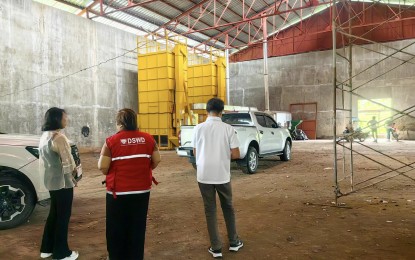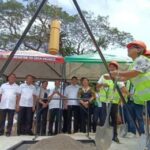BACOLOD CITY – The Department of Social Welfare and Development-Negros Island Region (DSWD-NIR) will establish a warehouse for the prepositioning of food and non-food items in the sixth district of Negros Occidental.
The Disaster Response Management Division (DRMD) reported that a team inspected the proposed warehouse in the municipality of Candoni on Monday.
They also paid courtesy visits to the cities of Kabankalan, Himamaylan, and La Carlota, which are among the local government units (LGUs) affected by floods in central and southern Negros due to monsoon rains last week.
“DSWD-NIR remains steadfast in enhancing local disaster response capacity and ensuring immediate assistance reaches affected families,” the DRMD said.
Meanwhile, the distribution of family food packs continued in southern Negros on Tuesday for affected residents in Valladolid, San Enrique, Ilog, Pontevedra, Isabela, and Binalbagan.
Data showed 44,378 families or 166,335 persons in Negros Occidental were affected by the continuous rains and floods.
At least 1,287 families or 4,802 persons who stayed in 40 evacuation centers received relief assistance, while 9,111 families or 44,680 persons staying outside evacuation centers were also assisted.
Mostly affected are the LGUs located in the fifth district, including Hinigaran, Binalbagan, Isabela, Moises Padilla, and Himamaylan City; as well as in the sixth district’s Ilog, Cauayan, Candoni, Hinoba-an, Kabankalan City, and Sipalay City.
Assistance provided to affected residents has amounted to PHP13.26 million as of Tuesday.
Candoni, Negros Occidental
Candoni is a small town in Negros Occidental, Philippines, known for its rich cultural heritage and agricultural economy, particularly sugarcane farming. Established in 1956, it was once part of the larger municipality of Ilog and is home to the annual *Dinagsa Festival*, which celebrates its patron saint, the Sto. Niño, with vibrant street dancing and local traditions. The town’s history reflects the resilience and strong community spirit of its people.
Kabankalan
Kabankalan is a city in the Negros Occidental province of the Philippines, known for its vibrant culture, agricultural heritage, and scenic landscapes. Historically, it was a small settlement that grew into a major sugar-producing hub during the Spanish colonial era. Today, it is also famous for the *Binuligay Festival*, which celebrates the city’s traditions and local crafts.
Himamaylan
Himamaylan is a historic city in Negros Occidental, Philippines, recognized as one of the oldest settlements in the region. It served as the capital of Negros Island during the Spanish colonial period before Bacolod took over in 1849. Today, it is known for its cultural heritage, scenic landscapes, and landmarks like the centuries-old St. John the Baptist Church.
La Carlota
La Carlota is a city in the province of Córdoba, Argentina, founded in 1797 as a military outpost to protect against indigenous raids and to secure trade routes. It played a key role in the region’s development during the Spanish colonial period. Today, it is known for its historic architecture, including the Church of Nuestra Señora del Carmen, and its cultural heritage.
Valladolid
Valladolid is a historic city in Spain, once the capital of the Spanish Empire in the early 17th century under King Philip III. Known for its Renaissance and Baroque architecture, it features landmarks like the Cathedral of Valladolid and the Plaza Mayor. The city is also famous for being the place where Christopher Columbus died in 1506.
San Enrique
San Enrique is a municipality in the province of Negros Occidental, Philippines, known for its agricultural economy, particularly sugarcane farming. Established as a town in 1854, it was named in honor of a Spanish royal, Enrique, and later developed into a key area for sugar production during the Spanish colonial era. Today, it remains a quiet, rural community with cultural ties to Negros’ sugar industry heritage.
Ilog
“Ilog” is a municipality located in the province of Negros Occidental, Philippines. Historically, it was established in 1743 and played a significant role during the Spanish colonial era as a center for sugarcane production. Today, it is known for its agricultural economy, scenic landscapes, and cultural heritage, including the annual “Pasalamat Festival,” which celebrates gratitude and local traditions.
Pontevedra
Pontevedra is a historic city in northwestern Spain’s Galicia region, known for its well-preserved medieval old town, charming squares, and rich maritime heritage. Founded as a Roman settlement, it flourished during the Middle Ages as a major trading port and later became a cultural hub. Today, its pedestrian-friendly center, Gothic churches like the Basilica of Santa María, and lively atmosphere make it a popular destination.






